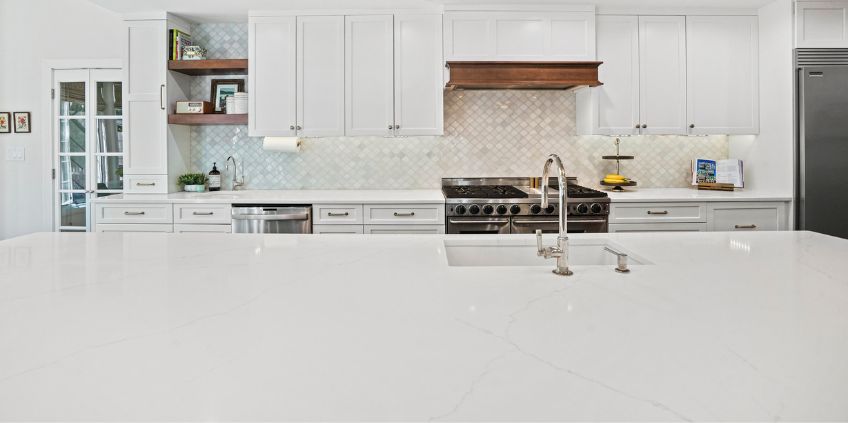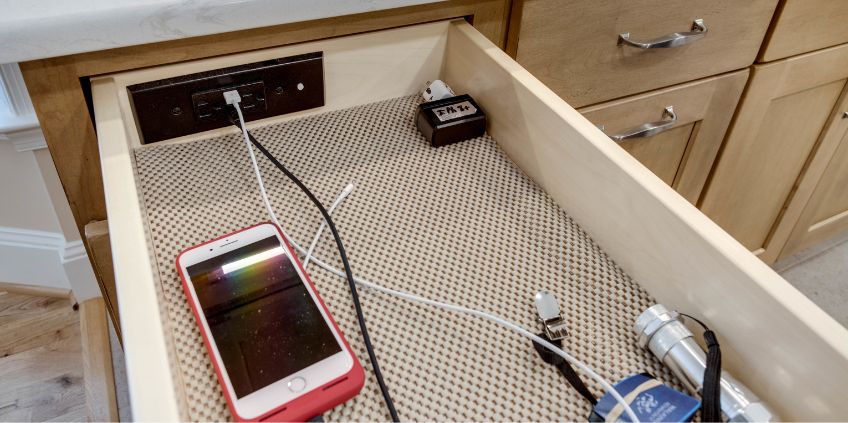The kitchen is more than just a place to cook—it's where families come together. For families with children, designing a kitchen that blends functionality with safety is paramount. Whether it's optimizing layout, incorporating safety features, choosing durable surfaces, or selecting family-friendly appliances, this article offers essential tips to help you craft a kitchen that enhances family life. From safer layouts and child-proofing measures to accessible storage solutions and versatile dining areas, each feature plays a crucial role in creating a family friendly kitchen design that serves as a hub for bonding and everyday convenience.
In addition to children, consideration must also be given when planning a kitchen that also supports family members aging in place to ensure that the space remains functional and accessible as they grow older. Let's explore eight essential features that can transform your kitchen into a space where safety meets style, and functionality meets the needs of the entire family.
1. Layout and Design

An open concept kitchen layout promotes interaction among family members and allows parents to supervise little ones easily. A kitchen island where kids can sit and participate in meal prep or complete homework while staying connected with family activities is a common design feature. Think hard over a breakfast bar though. Keeping your countertop at one lower but consistent height allows for better sight lines in and around kitchen, even into the living room. This is especially helpful when keeping an eye on younger children.
The work triangle—placing the sink, stove, and refrigerator in a triangular layout—creates an efficient workflow by minimizing the distance between these key areas. This ensures efficient movement during cooking and meal preparation, making tasks easier and quicker. Ample counter space around these areas provides room for multiple family members to work simultaneously, whether cooking, baking, or engaging in other activities. Ensure ease of use for everyone, including those with physical limitations or mobility challenges.
2. Safety Features

Implementing child-proofing measures in the kitchen is essential for ensuring a safe environment. Keep those little hands out of trouble by installing childproof locks on kitchen cabinets to keep cleaning supplies, sharp utensils, and other hazardous items out of reach. Stove guards prevent accidental burns, while rounded edges and corners on countertops and furniture reduce the risk of injuries from bumps and falls.
For aging-in-place, choose non-slip flooring materials like cork, rubber, or textured tiles to prevent slips, especially in high-traffic areas. Opt for floor tiles with sufficient grout and texture for better traction or consider porcelain tile for its low moisture absorption and easy maintenance. Vinyl flooring is another excellent option for its slip resistance and comfort, accommodating both young children and older adults with varying needs.
3. Kitchen Storage

A well-designed kitchen remodel is more than just aesthetics—it’s also about functionality and accessibility for every member of the family. When designing a family-friendly kitchen, consider these essential elements to ensure the space is practical for all ages and stages of life:
- Drawers vs. Doors: Opt for drawers over doors for cabinets and storage. Drawers provide easier access to items without less need to bend or stretch. This can be particularly beneficial for those with mobility challenges or for children who are still learning to reach and retrieve items. Deep drawers can also be more organized and less prone to items becoming cluttered or difficult to reach.
- Pull-Out Cabinets: Incorporate a pull-out storage cabinet into your kitchen design. From tall pantry cabinets to base pull-outs for spices, utensils and more, this feature allows you to see all of your items at a glance without needing to shuffle things around. It’s convenient for everyone, including children and older adults, as it reduces stretching or bending. Organize your pantry with clear containers for easy identification and adjustable shelving to accommodate various sizes and shapes of items.
- Accessible Corners: Design kitchen corners to be easily accessible. Avoid a deep, hard-to-reach lower cabinet that will cause frustration and inconvenience. Consider Lazy Susans or adjustable pull-out trays to make the corners of your kitchen reachable and functional.
Integrating these storage ideas into your kitchen design creates a space that is both functional and welcoming for everyone, ensuring that your kitchen supports the needs of your family now and in the future.
4. Durable and Easy-to-Clean Surfaces

Choose kitchen countertop materials such as quartz, granite, or laminate that are resistant to stains, scratches, and heat. These durable materials withstand daily wear and tear, making cleanup quick and easy—a valuable feature in a busy family kitchen.
If your budget allows it, consider continuing that granite or quartz countertop up the wall as a full height backsplash. Not only does it make wiping down food splatters easy, but it also looks sharp too.
For cabinets, opt for semi-gloss or gloss finishes as these surfaces are easier to wipe clean. Select materials that are durable and can withstand the recommended cleaning to maintain a neat and hygienic kitchen environment.
5. Family-Friendly Kitchen Appliances

A refrigerator with features like bottom-freezer and snack drawers offers everyone in the family easy access to. This encourages independence and allows young children to retrieve snacks and other items without assistance every time, fostering responsibility and autonomy.
Position your microwave at a comfortable height, preferably on or below the counter. This makes it easier for family members of all ages to access the microwave, reducing the need for bending or stretching. Keeping the microwave just below counter height also helps to save valuable counter space. Wherever it is placed, be sure that safety precautions are in place—every family member, especially young children, should be aware that the microwave’s contents can become very hot. Consider installing a safety lock or practicing safe behaviors when handling hot items.
Choose dishwashers with a child lock feature and intuitive design features that simplifies loading and unloading dishes. This encourages children to participate in household chores safely and effectively, promoting teamwork and responsibility.
Induction cooktops offer a safer alternative to traditional stove tops. By remaining cool to the touch even while in use, they reduce the risk of burns and provide peace of mind for parents. Its precise temperature control and fast heating capabilities make it an efficient and safe choice for cooking family meals.
6. Multi-Functional Spaces

Integrate a designated homework station within the kitchen area. This can be part of an island or, if space permits, a desk or seating area. This allows children to complete school assignments or projects while parents prepare meals, promoting productivity and family togetherness. Ensure that the space is designed with accessibility in mind, making it easy for both children and adults to use comfortably.
Create a centralized family message center equipped with a chalkboard wall, bulletin board, and charging station. This space serves as a hub for organizing ever-changing schedules, posting notes, and sharing important reminders among family members, keeping everyone informed and connected.
7. Family Friendly Dining Area

Select seating options that are comfortable and age-appropriate, such as bench seating, highchairs, or adjustable stools. Choose materials that are easy to clean and maintain, ensuring durability and longevity. Opt for upholstery and furnishings made from durable, stain-resistant fabrics or vinyl, which withstand spills and stains from everyday use. Collectively, this makes cleaning up after meals or activities simpler while preserving the aesthetic appeal of your dining area.
Invest in a dining table that can expand or adjust to accommodate varying family sizes and guest accommodations. A versatile table promotes flexibility and adaptability for larger family gatherings, meals, and activities, enhancing the functionality of your dining space.
8. Lighting

Maximize natural light in your kitchen by taking advantage of windows, sliding doors, or even skylights. Natural light creates a welcoming and inviting atmosphere, reducing the need for artificial lighting and saving energy.
Add task lighting under cabinets and over work areas like the kitchen island to enhance visibility for cooking, food preparation, and other tasks. Task lighting improves safety and efficiency in the kitchen, ensuring adequate illumination where needed.
Dimmable lighting offers options to adjust brightness levels according to different activities and times of day. Dimmable lights create a versatile ambiance suitable for family meals, gatherings, and evening routines, enhancing the overall comfort and functionality of your kitchen space.
Creating Your Family Friendly Kitchen
Designing a family friendly kitchen space requires thoughtful consideration of safety, functionality, and convenience. By incorporating these eight essential features—optimized layout, safety measures, accessible storage, durable surfaces, family friendly appliances, multi-functional spaces, kid-friendly dining areas, and strategic lighting—you can create a kitchen that supports family bonding while also enhancing daily routines. From morning breakfasts to evening meals and everything in between, your kitchen will adapt to the evolving needs of your household.
If you're unsure or feeling overwhelmed, our team at Reico Kitchen & Bath can guide you through every step of the kitchen remodeling process. Making decisions about your kitchen's design is important. Let's discuss and weigh each choice carefully to ensure it aligns with your family's lifestyle and preferences. Contact us today to start planning your ideal family-friendly kitchen!

